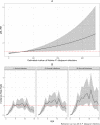Burkitt lymphoma risk shows geographic and temporal associations with Plasmodium falciparum infections in Uganda, Tanzania, and Kenya
- PMID: 36595676
- PMCID: PMC9926229
- DOI: 10.1073/pnas.2211055120
Burkitt lymphoma risk shows geographic and temporal associations with Plasmodium falciparum infections in Uganda, Tanzania, and Kenya
Abstract
Endemic Burkitt lymphoma (eBL) is a pediatric cancer coendemic with malaria in sub-Saharan Africa, suggesting an etiological link between them. However, previous cross-sectional studies of limited geographic areas have not found a convincing association. We used spatially detailed data from the Epidemiology of Burkitt Lymphoma in East African Children and Minors (EMBLEM) study to assess this relationship. EMBLEM is a case-control study of eBL from 2010 through 2016 in six regions of Kenya, Uganda, and Tanzania. To measure the intensity of exposure to the malaria parasite, Plasmodium falciparum, among children in these regions, we used high-resolution spatial data from the Malaria Atlas Project to estimate the annual number of P. falciparum infections from 2000 through 2016 for each of 49 districts within the study region. Cumulative P. falciparum exposure, calculated as the sum of annual infections by birth cohort, varied widely, with a median of 47 estimated infections per child by age 10, ranging from 4 to 315 infections. eBL incidence increased 39% for each 100 additional lifetime P. falciparum infections (95% CI: 6.10 to 81.04%) with the risk peaking among children aged 5 to 11 and declining thereafter. Alternative models using estimated annual P. falciparum infections 0 to 10 y before eBL onset were inconclusive, suggesting that eBL risk is a function of cumulative rather than recent cross-sectional exposure. Our findings provide population-level evidence that eBL is a phenotype related to heavy lifetime exposure to P. falciparum malaria and support emphasizing the link between malaria and eBL.
Keywords: East Africa; Plasmodium falciparum malaria; endemic Burkitt’s lymphoma (eBL); epidemiology; non-Hodgkin lymphoma.
Conflict of interest statement
The authors declare no competing interest.
Figures



References
-
- Molyneux E. M., et al. , Burkitt’s lymphoma. The Lancet 379, 1234–1244 (2012). - PubMed
-
- Basso K., Dalla-Favera R., Germinal centres and B cell lymphomagenesis. Nat. Rev. Immunol. 15, 172–184 (2015). - PubMed
-
- Bouvard V., et al. , Carcinogenicity of malaria and of some polyomaviruses. Lancet Oncol. 13, 339–340 (2012). - PubMed
-
- Carpenter L. M., et al. , Antibodies against malaria and Epstein-Barr virus in childhood Burkitt lymphoma: A case-control study in Uganda. Int. J. Cancer 122, 1319–1323 (2008). - PubMed
Publication types
MeSH terms
Grants and funding
LinkOut - more resources
Full Text Sources
Medical

